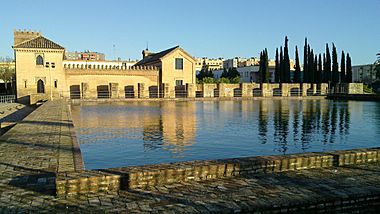Buhaira Gardens facts for kids
The Buhaira Gardens, also known as the Buhaira Palace, is a historic garden and palace in Seville, Spain. It was built in the 12th century by the Almohad rulers. After the Reconquista (when Spanish Christians took over), it was sometimes called the "Garden of the King." Today, it's a public park and an important historical site for everyone to enjoy.
Contents
What's in a Name?
The name Buhaira comes from an Arabic word, buḥayra. This word means "little sea." This name was used for many gardens and country homes during the Almohad time (12th-13th centuries). These places often had artificial lakes or large water pools. For example, the famous Agdal Gardens in Marrakesh, Morocco, also had a similar name.
A Look Back: History of the Gardens
Building the Buhaira
The Buhaira complex started being built in 1171. It was ordered by the Almohad ruler Abu Yaqub Yusuf. He also ordered many other building projects in Seville. This included the new Great Mosque, which is now the Cathedral. At that time, Seville was the main city for the Almohad rulers in Al-Andalus (parts of Spain and Portugal).
The new country estate was built near an existing natural lagoon. It was just outside the eastern city walls. Its design was similar to other Almohad estates. These were found near Rabat and Marrakesh in Morocco.
Who Designed It?
Historical records say that Ahmad ibn Baso designed the palace building. He was the same architect who designed the Great Mosque. The gardens were overseen by the governor of Seville, Shaykh Abu Dawud ibn Gallul. An engineer named Al-Hajj al-Ya'ish designed the water system. He also worked on projects in Marrakesh.
The gardens got their water from an old Roman aqueduct. This aqueduct is now known as the Caños de Carmona. Abu Yaqub Yusuf had it rebuilt to supply water to both this palace and the larger Alcazar Palace. The palace and gardens were finished in February 1172. They were opened with a big celebration.
Later Years and Restoration
After Spanish Christians took control of Seville, the gardens were left empty for many years. In the 19th century, a new Mudéjar-style palace was built. It stands next to the water pool today. This new palace was built over the foundations of an older Almohad palace.
Archaeologists started studying and digging at the site in 1971. More studies and digs happened in the 1980s and 1990s. After this, the site was fixed up and became a public park. It opened in 1999. A major road, Avenida de la Buhaira, now runs through the old estate. It is right next to the restored water basin.
What Did It Look Like?
Walls and Water
The gardens and palaces were originally surrounded by a wall. It was made of rammed earth. This wall was called the Ha'it as-Sultan, meaning "Wall of the Sultan."
The Almohad water reservoir has been restored and you can still see it today. It is 43 meters by 43 meters wide and 2 meters deep. The walls of the reservoir rise slightly above the ground. They are strengthened with buttresses (supports). Water came from an aqueduct to the east. It flowed into the reservoir through a spout on the south side. Any extra water from the aqueduct continued past the reservoir. It then flowed into the gardens to the west. Three other drains also allowed water to leave the reservoir.
Pavilions and Plants
The remains of a square pavilion have been found on the south side of the reservoir. It was lined up with the center of the reservoir. This is where the water entered. This pavilion might have been open on all sides. It could have been a place for the ruler to relax and enjoy the view. It might have had a dome or a pyramid-shaped roof.
A much larger rectangular palace or pavilion was on the eastern side of the reservoir. Some of its foundations are still visible today. It had a large central hall with smaller rooms on the sides. These rooms were surrounded by an arcaded gallery (a row of arches). The corners of the building had strong square buttresses.
Historical records say that the gardens around the reservoir and palace were full of fruit trees. There were about ten thousand pear, apple, fig, and olive trees. These trees were still there in 1195. Later, in the late 1400s or early 1500s, a visitor noted that orange trees grew around the reservoir.
Some parts of the palace and reservoir design were similar to older palaces from the 10th century. For example, Madinat al-Zahra. In turn, the design of the Buḥayra palace might have influenced later palaces. These include the Partal Palace and the Generalife in the Nasrid kingdom.
Images for kids
See also
 In Spanish: La Buhaira para niños
In Spanish: La Buhaira para niños




